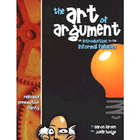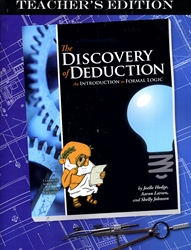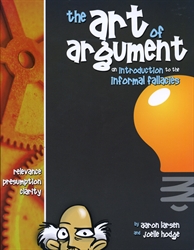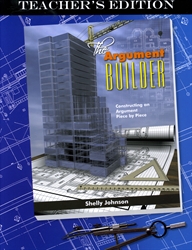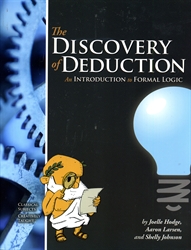Classical Academic Press publishes a series of three logic courses. Students should begin with The Art of Argument, then they can use the other two courses in whatever order they choose.
The Art of Argument
by Aaron Larsen and Joelle Hodge
The Art of Argument introduces students to informal fallacies, but at a slightly more challenging level than the The Fallacy Detective. The content and style of delivery make this most suitable for high school level, although some students in junior high might be ready for it.
This course incorporates humor with examples drawn from current events, popular culture, advertising, religion, politics, and history. The course seems to have been written for Christian students since it draws on examples familiar to and of interest to them, but that shouldn't preclude secular homeschoolers from using it.
There are loads of photos and illustrations, many of them humorous. These include many phony print advertisements created by the authors that look authentic but which embody one or another of the fallacies. The authors also sometimes create dialogues between two students, Nate and Tiffany, and the philosopher Socrates.
The text begins with an introduction to logic then divides the rest of the text into two units. The first unit deals with fallacies of relevance (e.g., ad hominem, snob appeal) and the second with fallacies of presumption (e.g., begging the question) and clarity (e.g., distinction without a difference).
Lessons don’t follow a consistent format, which keeps things interesting. Review questions, review exercises, worksheets, and “dialectic exercises” show up unpredictably. Some writing is required and some review exercises direct students to do research such as “Look for examples of print advertisements that make use of the argumentum ad verecundiam” (p. 86).
The text has a glossary at the end and a chart of the fallacies printed on the inside front and back covers. Two appendices include some extras you might want to use. One is a script for “Bill and Ted’s Excellent Election,” that can be read or acted out. The other is a dated but apropos short story, “Love is a Fallacy” by Max Shulman.
The course can easily be used for independent study, but it would be fun to have a group class meet once a week for discussion.
The teacher’s edition has the entire student text with answers overprinted. It also has quizzes, tests and answer keys.
Busy parents might appreciate the new Art of Argument DVD set that includes five DVDs with 28 presentations—one for each fallacy that is taught. On the DVDs, four experienced logic teachers and a small group of students model discussions for each lesson.
The Argument Builder
By Shelly Johnson
While The Art of Argument teaches students to identify bad arguments, The Argument Builder helps students learn to construct strong or valid arguments. This course requires significantly more reading and writing than The Art of Argument. There are far fewer illustrations. Author Shelly Johnson ushers students through a process of building arguments, beginning with definitions then working through the different elements: the use of testimony to buttress arguments and the use of comparisons, relationships, and circumstances.
The issue of school uniforms recurs throughout the book as a key “theme” for the various lessons, although many other topics are also introduced. The book ends with an appendix on “Holding a Debate”; the debate is supposed to be about school uniforms. Most home educated students can probably understand the issues related to school uniforms even though the school dynamics might be outside their experience. Even though students have been thinking and writing about school uniforms, it might be good to come up with a more pertinent topic for a first debate among home educated students.
Lessons begin with text and are followed by questions. Often interspersed with the questions are brief passages to be analyzed--some written by the author of this text and others by authors such as John Donne, Francis Bacon, Thomas Aquinas, and Thomas Paine. The questions include defining terms, identifying the thesis of a passage, and other comprehension type questions. But far more time is spent on analysis and work with the various components of arguments. While very little research is required, students can learn to build stronger arguments by doing additional research on some of the topics, especially if they participate in a debate. A glossary is at the back of the book.
While students can work through this text independently, they would get more out of studying it through a group class of some sort. Brainstorming and discussing ideas with others would greatly enhance the learning process. Some of the questions might be used for discussion rather than as written assignments. And, obviously, participating in a debate requires a group of some sort. There’s enough Christian content in this book that it really works best for Christian students.
The Teacher’s Edition for this course reprints the entire student book with overprinted answers. It adds a page of teaching suggestions, a few pages of teacher’s notes, and “additional exercises” for each chapter that you could use as supplements or assessment tools.
The Discovery of Deduction
By Joelle Hodge, Aaron Larsen, and Shelly Johnson
All three authors involved in the first two books contribute to The Discovery of Deduction. While the publisher suggests it might be used with students as young as eighth grade, it’s more likely that you will use it with high school students.
This is an introduction to formal logic and its symbolic language. The course begins with categorical logic then moves on to propositional logic. However, it makes real life applications to keep it interesting and practical rather than just theoretical.
It uses Socratic dialogues throughout the text. In the introductory chapter students are told to read Socrates’ Apology online then answer a series of questions. Students participate in reading, research, discussion, and written activities.
The student and teacher books are laid out in a fashion similar to The Argument Builder. The Teacher’s edition includes student pages overprinted with answers.

